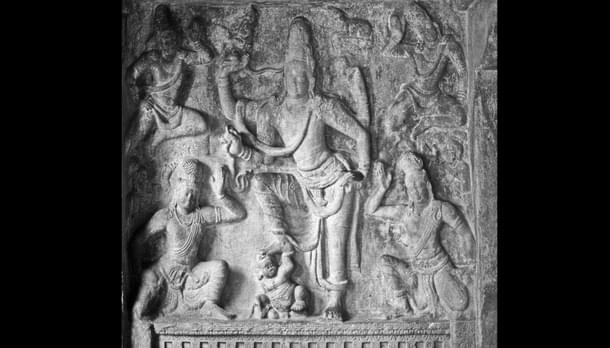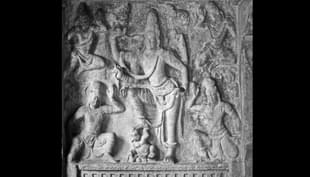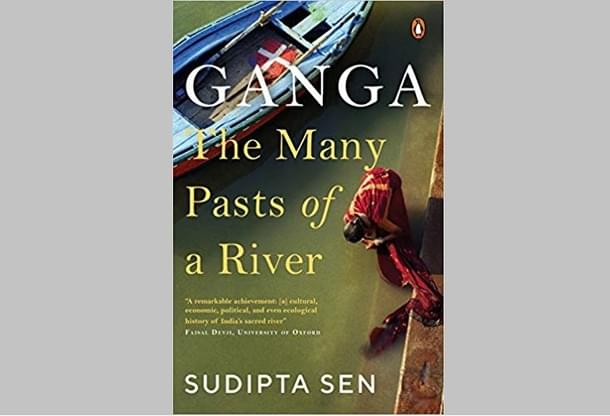Magazine
Ganga Through The Ages And Empires
Sudipta Sen
Apr 01, 2019, 10:29 PM | Updated 10:29 PM IST
Save & read from anywhere!
Bookmark stories for easy access on any device or the Swarajya app.


Ganga: The Many Pasts Of A River. Sudipta Sen. Penguin Viking. Rs 495. 464 pages.
Within a hundred years of the end of Harsha’s empire, the arena of imperial rivalry had shifted to the south. In the political drama that unfolded over the seventh and eighth centuries c.e. in the Deccan, the Western Gangas, the Pallavas of Kanchi, the Chalukyas of Badami, and Pandya kings farther down the peninsula were embroiled in a struggle for political supremacy that brought about an extensive period of intrigue and military raids. The Western Gangas, based in present day Karnataka, were once vassals of the Pallavas but asserted their independence with the rise of the Chalukyas in the western Deccan and eventually allied with the Chalukyas against the Pallavas. Around 617 c.e. the Chalukya forces under Pulakeshin II had forced their way into the outskirts of Kanchi, the capital of Pallava king Mahendravarman I.
While they could not take the capital, they inflicted heavy losses on the Pallava forces at a place called Pullalur. To avenge this debacle the Pallava king Narasimhavarman I attacked the Chalukya capital Vatapi (Badami) in 642–643 c.e. and burned it to the ground. After the sack of the city, he took the title of VatapiKonda, “the conqueror of Vatapi.” The two regimes were henceforward locked in a series of deadly raids and counter raids that lasted for generations. Under Vikramaditya I (greatgrandson of Pulakeshin II), the Chalukyas would finally overcome their rivals and expel them from their homeland.

During these fierce contests, the temple served as a direct symbol of political power. The Pallava king Narasimhavarman commissioned the Mallikarjuna temple in the heart of the Chalukya capital, with an inscription proclaiming his military triumph over his Chalukya rivals. In a fitting riposte, Queen Lokamahadevi, wife of Vikramaditya I, had the Virupaksha temple built in 745 c.e. to commemorate the victory of her husband, “captor of Kanchi,” over the Pallavas. In both these monuments, the River Ganga appears as a deliberately chosen motif. In the Mallikarjuna temple, Ganga and Yamuna are installed as guardian deities.
In the Virupaksha temple, Ganga is represented as flowing in all three directions—heaven, earth, and the netherworld—along with a recapitulation of the story of its descent. In fluid dynamic sequences carved meticulously in sandstone, the old myths are retold. The Vasus come to life in the act of being liberated from the curse of sage Vasishtha. There is a penitent Bhagiratha waiting to consecrate the remains of his ancestors, the sons of Sagara lying in a heap of ashes beside an enraged sage Kapila, and Ganga flowing into Shiva’s matted locks before splashing onto earth. Paintings of Ganga as Shiva’s consort once adorned the pillared courtyard (mandapa) of this temple, which can still be recognized in the fragments that have survived on the underside of the eaves. On the facade of the nave (garbhagriha) of the Papanatha temple in the Chalukya capital of Patadakkal, adorned with finely carved pilasters on both sides, Ganga and Yamuna appear astride their respective vehicles, the crocodile and the tortoise.
The recapitulation of stories from old Indian mythology on the walls of rival structures gives us some idea of how the Ganga was viewed, not only from the perspective of traditional cosmology but also as a manifest emblem of royal power and protection. As Cathleen Cummings has recently pointed out in the case of the Virupaksha temple, the site of its construction was also the place where the king was crowned—with the grand entrance to the temple facing the banks of the Malaprabha River. Indeed, there are panels dedicated to Shiva and Parvati playing a game of dice, scenes from a chariot drive, and images of Vishnu as the dwarf avatar (Trivikrama) who once covered the three worlds in one stride—each composition dedicated to a particular ritual associated with the coronation of Chalukya kings. The Pallava rockcut sculpture of the descent of the Ganga at the shore temple in Mahabalipuram, discussed earlier in this book, can be seen as a similar attempt to exalt the status of the dynasty. As art historian Padma Kaimal has suggested, this rendition of the myth of the Ganga—which can also be read as homage to Arjuna, the warrior hero of the Mahabharata—gives us an insight into how the Pallavas sought to incorporate the tale of Ganga’s descent into their new lexicon of sovereignty.
In this sense, the architect’s homage to the river may also be seen as a prayer to the actual rivers of the region for the wellbeing and prosperity of the kingdom. The Pallava kings wanted to extend their domains beyond the fertile basin of the Kaveri River, into the valleys of the Tungabhadra and the Krishna toward the west and north. An inscription of Simhavishnu, one of the early rulers of the dynasty, states clearly that he seized the territory of the Cholas of the north country “embellished by the daughter of Kavira,” that is, the river Kaveri, “whose ornaments are the forests of paddy” and where one can find the “brilliant groves of areca palms.”
A copper plate inscription of the Pallava king Nandivarman dating to the eighth century c.e. clearly shows an attempt by his scribes to relate the story of the descent of the Ganga to the descent of royal lineage. It states that the Pallavas were a powerful and untainted race of warriors, a part of Vishnu incarnate (vis.noram. s′avataˉra), who had demonstrated unrelenting courage in their conquest of all parts of the terrestrial sphere, enforcing rules of the caste order (varna), and they had descended on this earth just like the Ganga (gan˙ gaˉ vataˉra) to purify the world. In the light of such a claim, the proliferation of Ganga images in Pallava temples, either as freestanding guardians or displayed along with Shiva, makes perfect sense. In the cloisters and panels of the freestanding masonry temples built by the later Pallava kings we can see a further elaboration of this theme, with the rendition of Shiva as Gangadhara, catching the celestial river in his matted hair to break the impact of its fall on creatures of the earth. An early execution of this form can be found at the Tiruchirapalli rockcave temple, where Gangadhara stands with his foot on the dwarf Apasmara, a symbol of folly and ignorance.

At the Kailasanatha temple in the Pallava capital, Kanchi, Shiva holds out a single lock of his hair to receive the river hurtling down from heaven. Such images were meant to augment the reputation of the ruling dynasty, which is one reason why many of these temples were attacked and desecrated during times of war.
The appropriation of the Ganga motif during the long and unfinished struggle for dominance between rival powers of the Deccan—from the Narmada River in the north to the Kaveri in the far south—points to a different kind of war waged over icons and meanings. The patronage and construction of royal temples had become essential elements of statecraft. The evolution of the Pallava temple, for example, from smaller rockcut caverns and enclosures to massive freestanding structures on stone platforms endowed with lofty towers (vimana) and stepped cornices rising skyward toward elaborate golden capstones show this most clearly. The careful placement of guardians (dvarapalas) and guardian deities at the entrances of Pallava temples was an attempt to fashion the gates of the temple as entrances to the kingdom itself. The Pallava ruler Mahendravarman I, who initiated many of the dynastic feuds with the Pandya and Chalukya kingdoms, was an indefatigable patron of such structures. Many of them were named after his honorific titles (birudas) in Sanskrit, Tamil, and Telugu, such as the uppercave temple at Tiruchirapalli, famous for the image of Shiva as Gangadhara, bearer of the Ganga.
These were massive undertakings that involved breaking, cutting, carving, and polishing giant slabs of stone or the refashioning of freestanding monolithic structures as in the chariot shaped Pancha Ratha temples of Mahabalipuram. Many of these projects outlived the rulers who commissioned them, and some lie unfinished to this day. The ubiquity of the Ganga image in Chalukya and Pallava temples as door guardian, goddess of bounty, or loving companion of Shiva entangled in the coils of his matted hair, not to mention the frequent invocation of the river in royal inscriptions, reminds us of the suffusion of myths, icons, and texts in the fabrication of political legitimacy.
Placed within the sanctum of the king’s temple, the Ganga—the river that is supposed to emanate from the Milky Way galaxy—implied a communion between the ruler and the realm of Shiva in the northern mountains of Kailasa. The temple was a visible embodiment of the heights of royal power, reinforced by endowments, gifts, and charity. It was precisely because the temple and the deity enthroned therein were extensions of the king’s consecrated body that they were objects of great political value and vulnerable to attacks during times of war. For the regimes that succeeded the Pallavas and Chalukyas in the south, pillaging and desecration of idols and artifacts became increasingly common, sometimes involving distant regimes of the north. The construction, endowment, and defense of large temples, in this regard, were practices dedicated largely to the extension of the political aura and ritual preeminence of the ruler.





